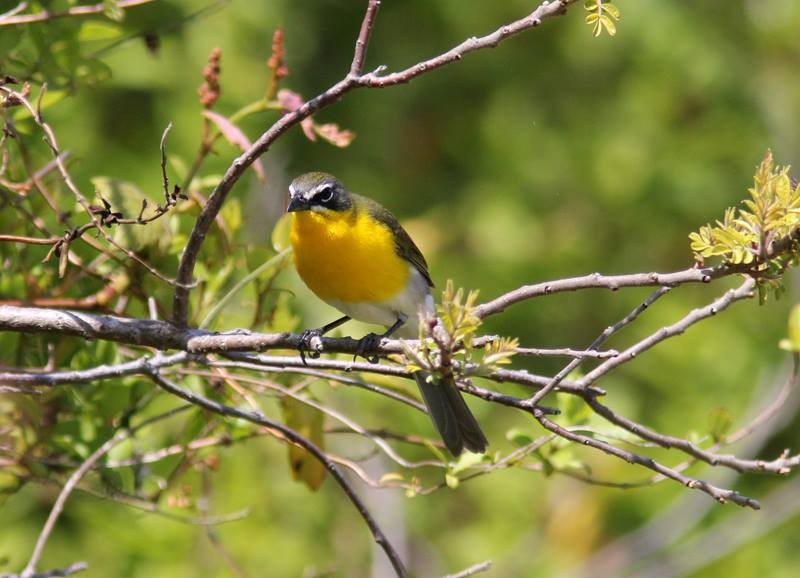Yellow-breasted Chat
A species of Chats Scientific name : Icteria virens Genus : Chats
Yellow-breasted Chat, A species of Chats
Botanical name: Icteria virens
Genus: Chats
Content
Description People often ask General Info
 Photo By Emily Willoughby , used under CC-BY-SA-3.0 /Cropped and compressed from original
Photo By Emily Willoughby , used under CC-BY-SA-3.0 /Cropped and compressed from original Description
If they are considered part of the family Parulidae (New World warblers), yellow-breasted chats are the largest species of parulid. In fact, they can often weigh more than twice as much as other parulid species, but their membership in this taxonomic family is disputed. This species reaches a total length of 17 to 19.1 cm (6.7 to 7.5 in) and a wingspan of 23 to 27 cm (9.1 to 10.6 in). Body mass can range from 20.2 to 33.8 g (0.71 to 1.19 oz). Among standard measurements, the wing chord is 7.1 to 8.4 cm (2.8 to 3.3 in), the elongated tail is 6.9 to 8.6 cm (2.7 to 3.4 in), the relatively long, heavy bill is 1.3 to 1.6 cm (0.51 to 0.63 in), and the tarsus is 2.5 to 3.1 cm (0.98 to 1.22 in). These birds have olive upper parts with white bellies and bright-yellow throats and breasts. Other signature features of yellow-breasted chats are their large, white eye rings, and blackish legs. When seen, this species is unlikely to be mistaken for any other bird. 
Size
18 cm (7.25 in)
Colors
Black
Yellow
Bronze
Gray
Life Expectancy
8 years
Nest Placement
Shrub
Clutch Size
3 - 6 eggs
Incubation Period
1 - 2 broods
Number of Broods
10 - 12 days
Nestling Period
7 - 10 days
Feeding Habits
Yellow-breasted Chat primarily consume spiders, insects (e.g., beetles, ants, bees, and caterpillars), and various berries (e.g., blueberries, blackberries). They forage in thickets, using feet to hold prey, and feed nestlings soft insects. In winter, their diet includes insects, spiders, and fruits.
Habitat
The yellow-breasted Chat is adapted to North America’s diverse shrub-filled landscapes, often found in abandoned fields, forest peripheries, and swamp edges. This species thrives in thickets, notably those comprising blackberry bushes, and inhabits shrubby riverbanks in arid regions. Its habitat spans from temperate to tropical climates, at low to moderate elevations. Yellow-breasted Chat also frequents wintering habitats like the Mexican lowlands to western Panama, often in shrubsteppe and riparian woodlands.
Nest Behavior
Yellow-breasted Chat rebuilds nests annually in previously used sites by different individuals. The female assembles it during breeding season, laying clutches typically of 3-5 eggs, and provides most care for eggs and hatchlings.
Nest Characteristics
Yellow-breasted Chat's nests are found 1–8 feet high in dense vegetation like raspberry or grapevine. They construct a bulky 5–6 inch wide cup from materials like grass, bark strips, and weed stems, with finer linings including pine needles and hair.
Dite type
Insectivorous
People often ask
General Info
Feeding Habits
Bird food type
Sounds
Song
Recording location: Mexico
Call
Recording location: United States
Song
Recording location: United States
Behavior
Yellow-breasted Chat exhibit distinct territorial and mating behaviors, especially in the breeding season. Males vigorously defend territories, engaging in combat at boundaries and performing impressive display flights, punctuated by unique wing-generated sounds, to woo females or deter rivals. Couples are mostly monogamous, though some males take multiple mates, and paternity can extend beyond the pair due to extra-pair fertilization. Females solely construct nests and incubate eggs, but both parents partake in feeding offspring. Known for their elusive nature, yellow-breasted Chat remain inconspicuous outside of mating displays, navigating stealthily through the underbrush or flying low across fields. In the non-breeding season, they lead a solitary lifestyle, maintaining individual territories with a sedentary disposition.
Distribution Area
The yellow-breasted chat is found throughout North America. It breeds from the southern plains of Canada to central Mexico, and mainly migrates to Mexico and Central America for the winter, although some may overwinter in coastal areas farther north. This species occurs in areas where dense shrubbery is common. Today, its habitat often consists of abandoned farmland and other rural areas where overgrown vegetation proliferates. 
Species Status
Not globally threatened.
Scientific Classification
Phylum
Chordates Class
Birds Order
Perching birds Family
New world warblers Genus
Chats Species
Yellow-breasted Chat